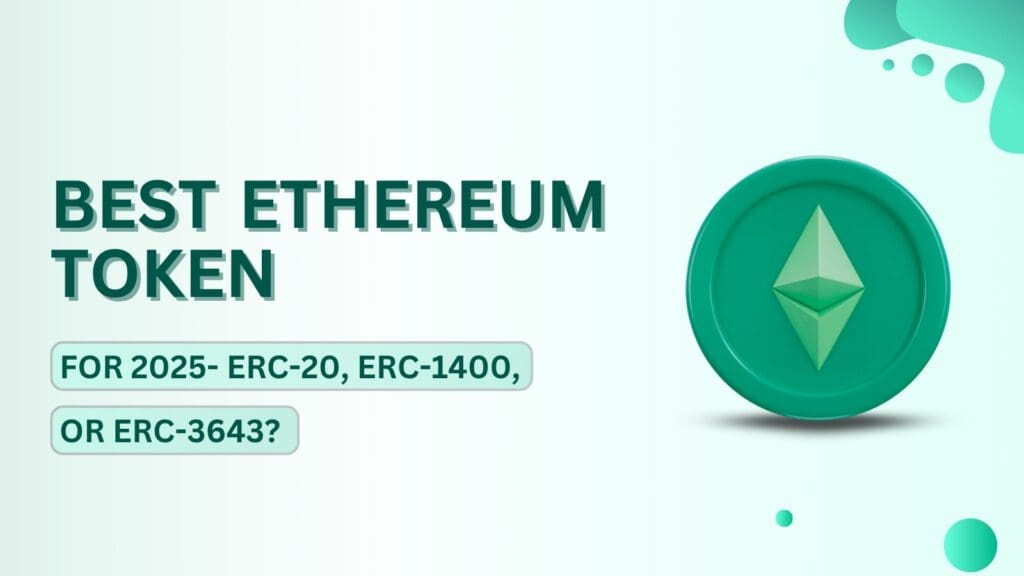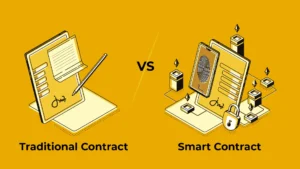
The Ethereum blockchain continues to evolve, and with it, the standards for creating and managing tokens. If you’re planning an Ethereum Token Launch in 2025, understanding the various Ethereum token standards is critical to your project’s success. Among the most recognized and debated standards today are ERC-20, ERC-1400, and ERC-3643. But which one is the best fit for your vision? Let’s explore.
What are Ethereum Token Standards?
Ethereum token standards are predefined sets of rules and functionalities that govern how tokens operate on the ethereum blockchain. These standards play a crucial role in ensuring interoperability and seamless interaction between various tokens and decentralized platforms within the Ethereum ecosystem. Different standards have been developed to cater to specific types of digital assets. For instance, ERC-20 is widely used for fungible utility tokens, ERC-721 is the go-to standard for non-fungible tokens (NFTs), and ERC-1400 and ERC-3643 are tailored for security tokens that require regulatory compliance.
Selecting the right token standard is essential and should be based on your project’s specific use case, regulatory obligations, and long-term business objectives. As we approach 2025, the industry focus is gradually shifting beyond simple utility tokens toward the development of regulated and compliant digital assets. This trend reflects the growing need for security, legal clarity, and trust in tokenized ecosystems, especially as governments and institutions introduce more stringent regulations around blockchain-based assets.
ERC-20- The Gold Standard of Utility Tokens
Since its proposal in 2015, ERC-20 has established itself as the most widely used Ethereum token standard. It is designed to support fungible tokens—digital assets that are interchangeable and divisible—making it ideal for applications such as voting tokens, stablecoins, and governance tokens within DeFi ecosystems. Its simplicity and reliability have driven widespread adoption, and it remains compatible with nearly all major Ethereum wallets, exchanges, and decentralized applications. This broad support has made ERC-20 the go-to standard for initial coin offerings (ICOs), DeFi projects, and basic utility tokens.
Key advantages of ERC-20 include its ease of deployment, extensive documentation, and a large developer community that offers a wide range of tools and integrations. Its proven track record and ecosystem support allow projects to launch tokens quickly and efficiently, with many ERC20 token development companies offering turnkey solutions. However, ERC-20 also has its limitations—most notably, it lacks built-in features for compliance, such as identity verification or regulatory controls. As the blockchain industry faces increasing regulatory scrutiny, these limitations may make ERC-20 less suitable for certain industries in 2025, especially those requiring strict adherence to legal frameworks.
ERC-1400- Built for Security Tokens
ERC-1400 was created to fulfill the increasing demand for security token issuance—tokens that represent real-world regulated assets such as equities, bonds, or real estate. It combines the transparency and efficiency of blockchain with features required for legal compliance, making it particularly valuable for institutions and enterprises operating in heavily regulated sectors. With support for permissioned transfers and built-in KYC/AML verification, ERC-1400 ensures that only authorized users can participate in token transactions. Its modular design allows for seamless upgrades, and the inclusion of embedded documentation simplifies audits and regulatory reporting.
Despite its advantages, ERC-1400 does present certain challenges. It is more complex to develop and integrate than ERC-20, and it currently has a smaller developer ecosystem. However, these drawbacks are outweighed by its ability to streamline compliance and offer enhanced security and customization. For organizations looking to tokenize financial instruments while meeting strict regulatory standards, ERC-1400 is a powerful solution. It is especially well-suited for projects that require Ethereum blockchain development services tailored to financial and institutional environments.
ERC-3643 (Formerly T-REX)- The Future of Regulated Assets?
ERC-3643, formerly known as T-REX (Token for Regulated Exchanges), is an advanced Ethereum token standard designed specifically for regulated and permissioned tokenization. It provides a comprehensive framework for digital assets that require strict compliance, real-time verification, and full control over transfer and ownership. Key features of ERC-3643 include identity-bound transactions, role-based access controls, and both off-chain and on-chain compliance verification mechanisms. It also allows for highly granular control over token issuance and transfers, ensuring that assets are only accessed and transferred by authorized individuals or entities.
While ERC-3643 is relatively new and has not yet reached the adoption levels of older standards, it is backed by practical, real-world applications in sectors like real estate, private equity, and tokenized funds. Its advanced compliance capabilities and seamless integration with both centralized and decentralized infrastructures make it particularly attractive for enterprises and institutions navigating complex regulatory environments. As blockchain technology continues to mature, ERC-3643 is well-positioned to become a leading choice for Ethereum blockchain solutions that demand full transparency, legal assurance, and operational control.
Comparative Analysis- ERC-20 vs ERC-1400 vs ERC-3643
All three Ethereum token standards—ERC-20, ERC-1400, and ERC-3643—support fungibility, but they differ significantly in terms of compliance capabilities. ERC-20, the most widely adopted standard, is ideal for utility tokens and DeFi projects due to its simplicity and vast ecosystem. However, it lacks built-in support for compliance, identity verification (KYC/AML), and permissioned transfers, making it less suitable for regulated environments.
In contrast, ERC-1400 and ERC-3643 are designed with regulation in mind. ERC-1400 includes built-in compliance features, permissioned transfers, and identity verification, making it a solid choice for security tokens. ERC-3643 takes this further by enabling role-based access controls and both on-chain and off-chain compliance checks, positioning it as the most advanced standard for regulated digital assets. While ERC-1400 has moderate developer support, ERC-3643 is growing rapidly and is well-suited for enterprise-grade applications in highly regulated sectors.
Which Token Standard Should You Choose in 2025?
The decision comes down to your business model and regulatory requirements.
-
Choose ERC-20
If you’re launching a DeFi project, a loyalty or rewards program, or any application that requires a straightforward, widely supported, and fungible token. With its extensive developer ecosystem and universal wallet compatibility, ERC-20 is ideal for projects that prioritize rapid deployment, ease of use, and integration with existing Ethereum infrastructure. It’s perfect for startups and businesses that want to focus on utility without the immediate need for complex regulatory compliance.
-
Go with ERC-1400
If your project involves issuing security tokens or requires features tailored for regulated financial instruments. This standard is well-suited for tokenizing equity, debt, or real estate assets, where compliance with KYC/AML laws and permissioned transfers is essential. ERC-1400 provides a modular and flexible framework that allows developers to integrate regulatory controls directly into the token, making it ideal for fundraising, investor onboarding, and institutional-grade blockchain solutions.
-
Opt for ERC-3643
If your project operates within a complex regulatory environment, or if you need cutting-edge identity verification and granular control over token ownership and transfers. This standard is designed for the future of regulated digital assets, offering role-based access control, off-chain and on-chain compliance integrations, and advanced governance mechanisms. ERC-3643 is particularly effective for enterprise applications, tokenized funds, private equity, and high-value asset management, where security, transparency, and regulatory adherence are non-negotiable.
As we move into 2025, regulatory clarity is increasing. Jurisdictions worldwide are adopting stricter policies for digital assets, making ERC-1400 and ERC-3643 more relevant than ever.
The Best Ethereum Token for Your 2025 Vision
If you’re looking for a future-proof token standard, ERC-3643 might be the best Ethereum token in 2025. It combines robust compliance tools with flexibility and advanced governance features. For companies building asset-backed tokens or targeting institutional investors, ERC-3643 is a game-changer.
However, the enduring utility of ERC-20 and the proven reliability of ERC-1400 mean they remain strong contenders based on specific use cases. Collaborating with an experienced ERC20 Token Development Company or Ethereum Blockchain Development Services provider can help you assess and implement the best-fit standard for your project.
Ready to Launch Your Next Ethereum Token? Let’s Build It Together!
At Nadcab Labs, we specialize in Ethereum token launches using ERC-20, ERC-1400, and ERC-3643 standards. With years of experience in Ethereum Blockchain Development, we provide end-to-end services—from token creation and smart contract development to regulatory compliance and platform integration.
Whether you’re building a DeFi app, launching a tokenized asset, or creating a compliant security token, we have the expertise to bring your vision to life in 2025. Contact us today to discuss your token strategy. The future of Ethereum starts with your next big idea — let’s build it together!






